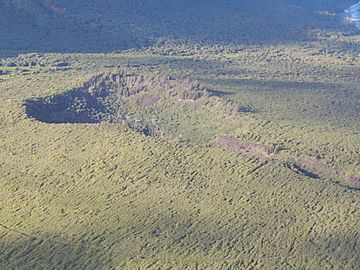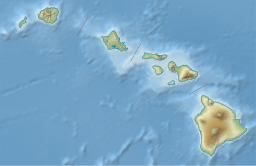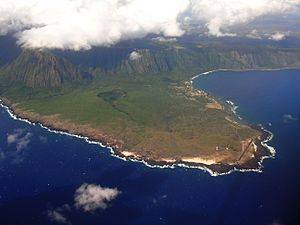Kauhakō Crater facts for kids
Quick facts for kids Kauhakō Crater |
|
|---|---|

Kauhakō Crater
|
|
| Highest point | |
| Elevation | 150 m (490 ft) |
| Geography | |
| Location | Hawaii, United States |
| Geology | |
| Mountain type | Volcanic crater |
Kauhakō Crater is a volcanic crater located in Kalawao County, Hawaii, United States. It formed a very long time ago, between 230,000 and 300,000 years back. This happened when a volcano called Pu'u 'Uao erupted.
You can find Kauhakō Crater in the middle of the Kalaupapa Peninsula on Molokaʻi island. It's about 500 metres (1,600 ft) wide and 650 metres (2,130 ft) long. At the bottom of the crater is Lake Kauhakō. This lake is super deep for its size, more than any other lake in the world! It's also the fourth deepest lake in the whole United States.
In 2011, something unusual happened: the lake 'turned over'. This caused a gas called hydrogen sulfide to come to the surface. Sadly, many small creatures like shrimp and plankton disappeared for a while.
How Kauhakō Crater Formed
Kauhakō Crater is believed to have formed between 230,000 and 300,000 years ago. During this time, an underwater volcano named Pu'u 'Uao first erupted.
This volcano kept erupting many times, sending out hot, fast-moving lava. When this lava cooled down, it created the land that is now the Kalaupapa Peninsula. Kauhakō Crater was formed as part of this process.
Where is Kauhakō Crater?
Kauhakō Crater is right in the center of the Kalaupapa Peninsula. It sits inside a volcanic rim, which is about 500 feet (150 m) above sea level. This makes it the highest spot on the peninsula.
The crater is shaped like a funnel. It measures about 500 metres (1,600 ft) by 650 metres (2,130 ft) across. Inside the crater, there's a flat area, like a step, about 150 meters wide, just above the lake.
Most of the crater is covered in trees and shrubs. You can find native plants like the wiliwili tree here. However, there are also many plants that are not from Hawaii, like the Brazilian peppertree and big-sage. Scientists have also noticed that black rats in the area are harming some native plants, especially a tree called Reynoldsia sandwicensis.
The crater also has many channels and tubes made by old lava flows. These vary a lot in size. One long lava channel, about a kilometer long, starts on the northeast side of the crater. It's up to 150 meters wide and 30 meters deep. Many smaller channels and tubes branch off from it.
Lake Kauhakō
At the bottom of Kauhakō Crater, you'll find a lake called Lake Kauhakō. The U.S. Navy has confirmed that the lake is 248 metres (814 ft) deep. But it's much narrower, only about 50 metres (160 ft) wide. This makes it the lake with the greatest depth-to-surface area ratio in the world! It's also the fourth-deepest lake in the United States.
The shallower parts of the lake have slightly salty water and lots of oxygen. This is where most of the lake's plants and animals live. You can find tiny creatures like plankton, shrimp, and copepods here.
The National Park Service checks the lake's water quality four times a year. They have been doing this since 2009. In September 2011, they saw a white layer on the lake's surface. This meant that hydrogen sulfide gas was rising to the surface and into the air.
Scientists think this 'overturning event' happened because of a drought. The surface water, which had a lot of oxygen, might have evaporated. Another idea is that a landslide caused it. After this event, the water quality changed a lot, especially the oxygen level. In August, there was a lot of oxygen, but by November, it had dropped very low. This caused many creatures in the lake, like shrimp and phytoplankton, to die.
Before 2011, no one had ever seen the lake act this way. After the event, people watched the lake closely. On December 8 and 12, 2011, the white layer was gone, and the lake looked bluish-green. But there were still no shrimp. A few days later, on December 14, heavy rain caused a green layer of phytoplankton to appear. This brought back shrimp and other life. However, by December 16, the lake was bluish-green again, and there was no life.



